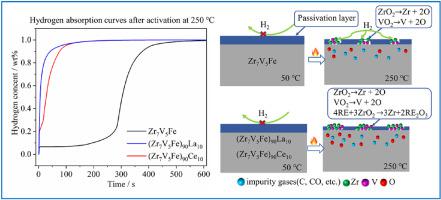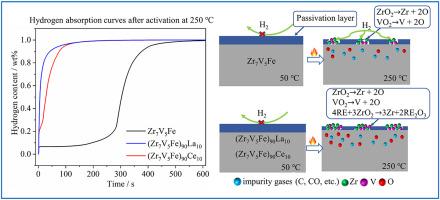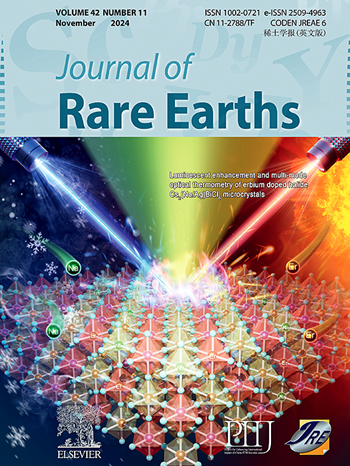稀土掺杂对 Zr7V5Fe 合金吸氢特性的影响
IF 7.2
1区 化学
Q1 CHEMISTRY, APPLIED
引用次数: 0
摘要
作为非蒸发获取剂的代表,Zr-V-Fe 因其低活化温度和快速吸氢率等优点而受到广泛关注。在本研究中,我们研究了掺杂 La 和 Ce 对 Zr7V5Fe 合金的热力学、动力学和活化特性的影响。X 射线衍射分析表明,稀土掺杂会导致 Zr7V5Fe 合金的 ZrV2 相和α-Zr 相的晶胞体积减小,从而导致合金的高原压增大。动力学曲线表明,稀土掺杂导致活化后的α-Zr 相变得粗大,粒度变大,从而降低了吸氢动力学特性。至于活化过程,掺杂稀土的合金在较短的孵化期内表现出优异的活化性能。X 射线光电子能谱研究表明,Zr 和 V 最初处于高度氧化状态。随着加热温度的升高,它们从氧化态过渡到金属态。在 250 ℃ 时,掺稀土合金中金属 Zr 的含量高于未掺稀土合金,这主要是由于稀土元素对氧的亲和性。本文章由计算机程序翻译,如有差异,请以英文原文为准。


Influence of rare earth doping on hydrogen absorption properties of Zr7V5Fe alloy
As a representative of non-evaporative getter, Zr–V–Fe has gained widespread attention due to its advantages including low activation temperatures and rapid hydrogen absorption rates. In this study, we investigated the impact of La and Ce doping on the thermodynamic, kinetic, and activation properties of Zr7V5Fe alloy. X-ray diffraction analysis shows that rare earth doping causes a decrease in the cell volume of both the ZrV2 and α-Zr phases of Zr7V5Fe alloy, which results in an increase in the plateau pressure of the alloys. The kinetic curves illustrate that rare earth doping leads to a coarse α-Zr phases and a larger particle size after activation, resulting in a decrease in the hydrogen absorption kinetic properties. As for the activation process, the rare earth doped alloys exhibit excellent activation with shorter incubation periods. X-ray photoelectron spectroscopy investigations reveal that Zr and V are initially in a highly oxidized state. As the heating temperature increases, they undergo a transition from oxidation state to metal state. The content of metal Zr in rare earth doped alloys is higher than that in undoped alloys at 250 °C, primarily due to rare earth elements' affinity for oxygen.
求助全文
通过发布文献求助,成功后即可免费获取论文全文。
去求助
来源期刊

Journal of Rare Earths
化学-应用化学
CiteScore
8.70
自引率
14.30%
发文量
374
审稿时长
1.7 months
期刊介绍:
The Journal of Rare Earths reports studies on the 17 rare earth elements. It is a unique English-language learned journal that publishes works on various aspects of basic theory and applied science in the field of rare earths (RE). The journal accepts original high-quality original research papers and review articles with inventive content, and complete experimental data. It represents high academic standards and new progress in the RE field. Due to the advantage of abundant RE resources of China, the research on RE develops very actively, and papers on the latest progress in this field emerge every year. It is not only an important resource in which technicians publish and obtain their latest research results on RE, but also an important way of reflecting the updated progress in RE research field.
The Journal of Rare Earths covers all research and application of RE rare earths including spectroscopy, luminescence and phosphors, rare earth catalysis, magnetism and magnetic materials, advanced rare earth materials, RE chemistry & hydrometallurgy, RE metallography & pyrometallurgy, RE new materials, RE solid state physics & solid state chemistry, rare earth applications, RE analysis & test, RE geology & ore dressing, etc.
 求助内容:
求助内容: 应助结果提醒方式:
应助结果提醒方式:


